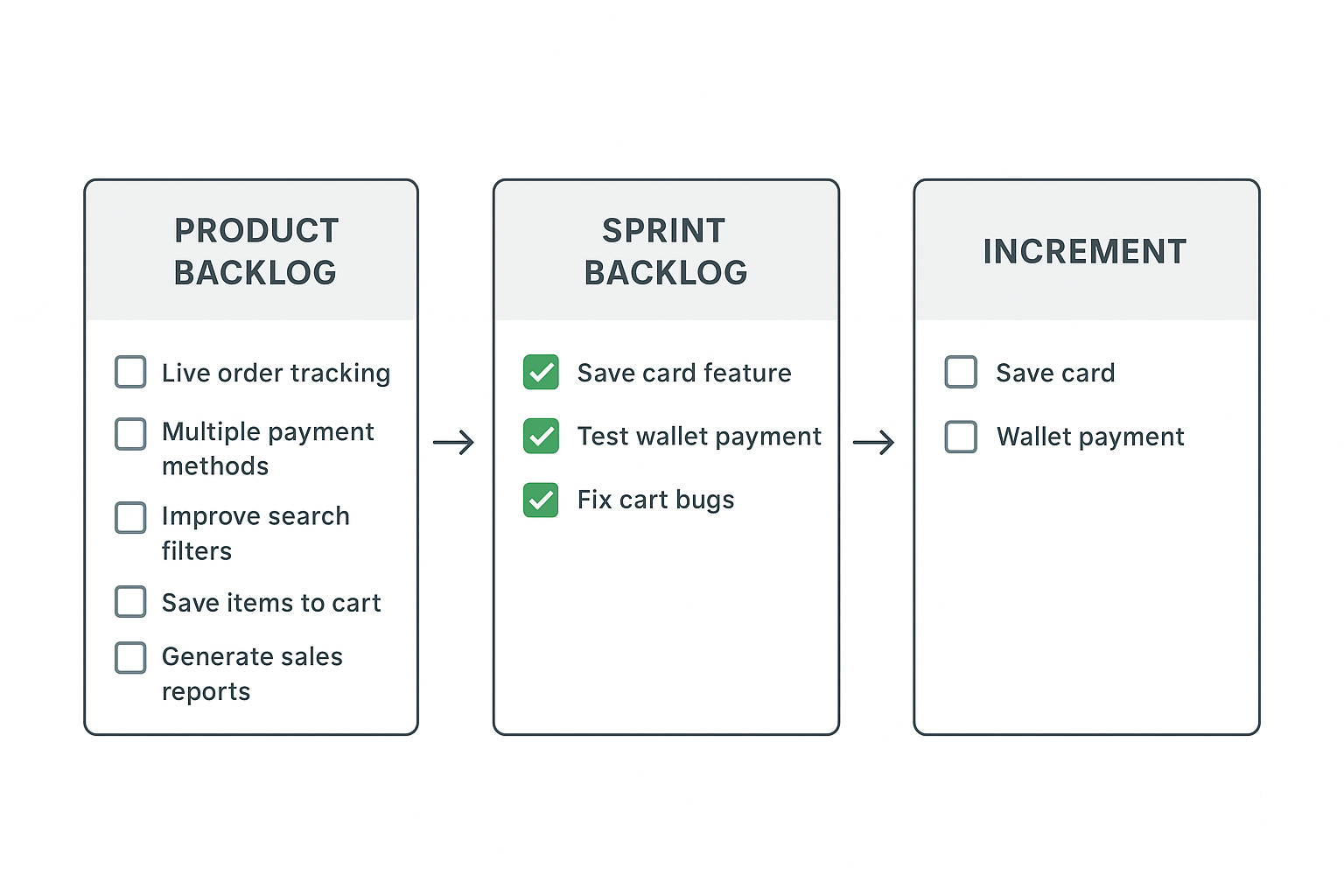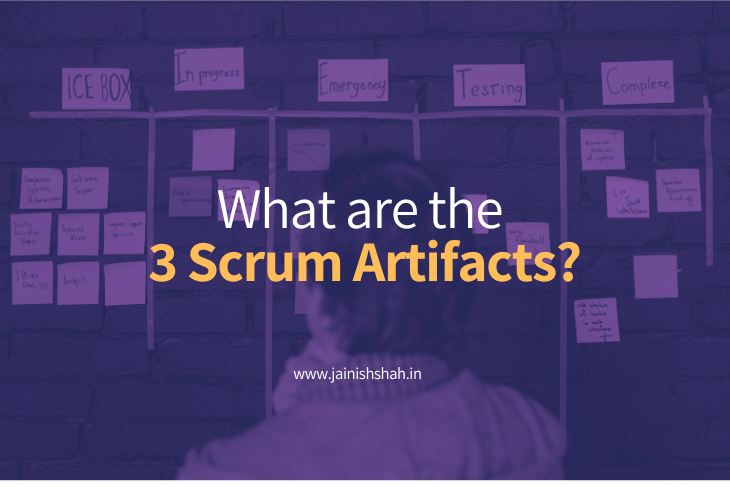The Scrum Artifacts are essential elements that provide transparency and help teams track progress toward delivering a product.
They serve as key sources of information for the Scrum Team, which includes the Product Owner, Developers, and Scrum Master, as well as for stakeholders. By looking at these Scrum artifacts, everyone can clearly understand:
- What work has already been done
- What still needs to be completed
- How much progress the project has made toward achieving its goals
Unlike static project documents, Scrum artifacts are living and evolving tools. They change and adapt as the product grows, as new requirements emerge, and as the team gains more insights during development.
The Scrum Guide defines three primary artifacts in Scrum:
- Product Backlog
- Sprint Backlog
- Increment
Each of these artifacts plays a unique role in ensuring alignment, transparency, and continuous delivery of value. They are continuously refined, updated, and reviewed to make sure the team is always focused on delivering the highest value in the shortest possible time.
Let’s dive deeper into these Scrum artifacts and explore their importance and role in the Scrum framework.
Product Backlog
The Product Backlog is a dynamic, ordered list of everything that might be needed in the product.
It captures all the work required to deliver a successful product, including:
- New features
- Enhancements
- Bug fixes
- Technical improvements
- Knowledge acquisition (like research or prototyping)
The Product Owner is responsible for owning and managing the Product Backlog. This includes prioritizing items based on business value, customer needs, and market demands.
While the Product Owner leads product backlog management, the whole Scrum Team can contribute by suggesting items or refining existing ones.
Key Features of the Product Backlog
1. Living Document
The Product Backlog is never complete. It evolves as the product grows and market needs change. New items may be added, while older or less relevant items may be refined, split, or even removed.
2. Prioritized
The Product Owner works closely with stakeholders to prioritize backlog items. This ensures the team always focuses on delivering the most valuable features first.
3. Ordered by Value
Typically, backlog items are ordered by the value they bring to the customer or business. High-value items sit at the top, ready to be picked up in upcoming Sprints, while lower-value or exploratory items remain lower until they’re needed.
For example, in an e-commerce application, the Product Backlog might contain user stories such as:
- As a user, I want to save items to my shopping cart so that I can buy them later.
- As an admin, I want to generate monthly sales reports so that I can track business performance.
- As a user, I want a faster checkout process so that I can complete my purchase quickly.
Each of these items is ranked in order of importance, with the most critical features prioritized for development in upcoming sprints.
Sprint Backlog
The Sprint Backlog is a subset of the Product Backlog that the team commits to delivering during the current Sprint.
It is created during the Sprint Planning meeting and represents the work that the Developers will focus on to achieve the Sprint Goal.
While the Product Backlog provides the big picture of “everything that could be done,” the Sprint Backlog narrows it down to “what we will do now.”
Ownership is key here: the Sprint Backlog is owned and managed by the Development Team. They decide how to deliver the selected items and are fully accountable for meeting the Sprint Goal.
Key Features of the Sprint Backlog
1. Sprint Goal Driven
Every Sprint Backlog is tied to a Sprint Goal. Sprint Goal is a short, focused statement describing what the team aims to achieve in that Sprint. This gives purpose and direction beyond just a list of tasks.
2. Transparent and Visible
The Sprint Backlog makes the team’s plan for the Sprint visible to everyone. It’s updated daily as progress is made or as adjustments are needed.
3. Living Plan
Just like the Product Backlog, the Sprint Backlog is not static. The team may refine tasks or re-plan as they learn more during the Sprint, as long as the Sprint Goal remains intact.
For example, in our e-commerce application, let’s say the Sprint Goal is:
“Improve the checkout experience to reduce cart abandonment.”
The Sprint Backlog for this Sprint might include:
- Add “Save card” feature for faster payments
- Fix bugs in the cart flow
- Test wallet payment integration
The team will then break these items into smaller tasks and track progress daily, ensuring they stay aligned with the Sprint Goal. These tasks are part of the Sprint Backlog and will be completed by the Development Team during the sprint.
Increment
The Increment or the Product Increment is the tangible outcome of a Sprint.
It represents the working product that incorporates all the completed Product Backlog items from the Sprint, integrated with the work from previous Sprints.
An Increment must be usable, valuable, and meet the team’s Definition of Done (DoD). This ensures consistency, quality, and readiness for release, even if the Product Owner decides not to release it immediately.
Unlike the Product Backlog (a list of possibilities) or the Sprint Backlog (a plan for this Sprint), the Increment is the actual progress made, a step closer to achieving the Product Goal.
Key Features of the Increment
1. Definition of Done (DoD)
Only work that meets the agreed quality standards (the DoD) is considered part of the Increment. This ensures transparency and prevents incomplete or low-quality work from being counted as “done.”
2. Potentially Shippable
Each Increment should be in a state where it could be released to users, even if the Product Owner chooses to wait. This creates confidence for stakeholders that value is being delivered continuously.
3. Builds on Previous Work
An Increment doesn’t stand alone. It adds to all previous Increments, creating a growing, evolving product.
For example, at the end of a Sprint, the Increment for our e-commerce app might include:
- A functional shopping cart with “add to cart” and “remove from cart” features
- A checkout page where users can enter payment details and complete a purchase
While this Increment may not represent the final product, it is still a fully functional part of the product that delivers value to users. Importantly, it is in a potentially shippable state, meaning the Product Owner could choose to release it to customers immediately or hold it for a future release.
Conclusion: The Value of Scrum Artifacts
The three Scrum artifacts, Product Backlog, Sprint Backlog, and Increment, are fundamental to the Scrum framework.
They serve as the backbone for tracking progress, managing work, and ensuring alignment across the Scrum Team.
- The Product Backlog provides a dynamic, prioritized list of everything that could be needed in the product, always ordered by business value.
- The Sprint Backlog helps the Development Team stay focused on the Sprint Goal, with clear, actionable tasks for the current Sprint.
- The Increment represents the tangible outcome of the Sprint, showing progress and delivering value in a potentially shippable form.

By effectively using these artifacts, Scrum teams can:
- Maintain transparency across all stakeholders
- Ensure alignment with customer and business priorities
- Deliver value early and often
- Continuously inspect and adapt as they learn
In short, Scrum artifacts aren’t just documents or lists; they are living tools that enable Agile product management, helping teams focus, collaborate, and deliver value consistently.
Whether you’re building a new product or scaling an existing one, mastering Scrum artifacts is key to successful Agile delivery.
